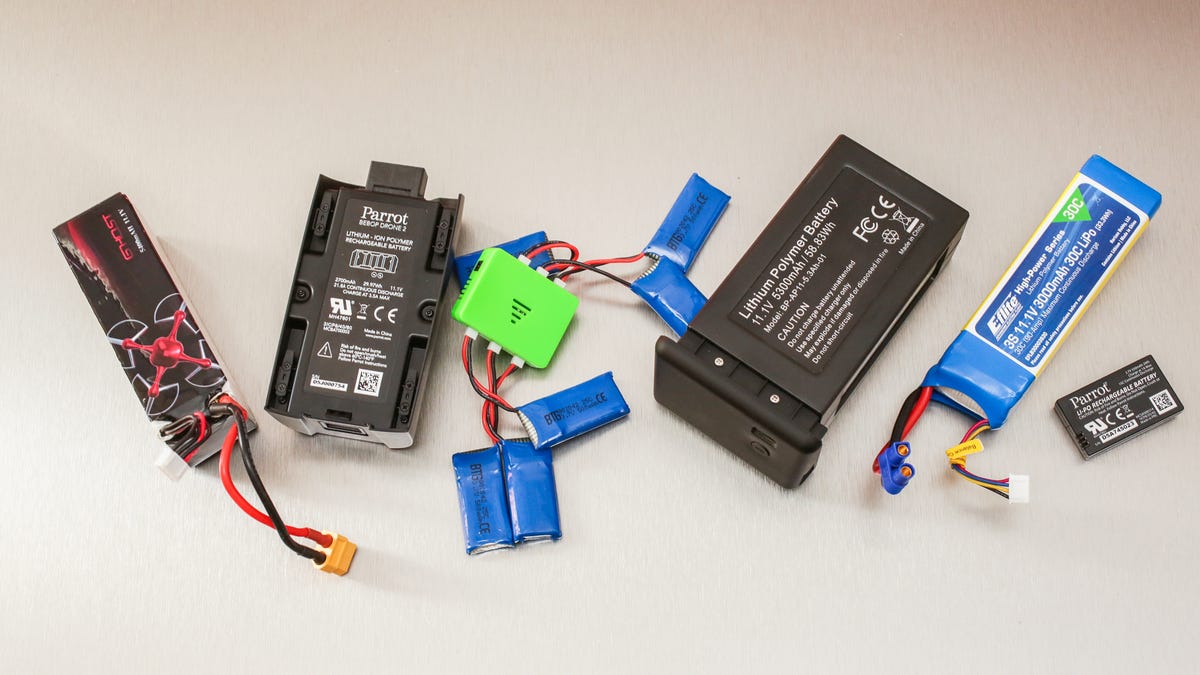 Why You Can Trust CNET
Why You Can Trust CNET How to keep your drone batteries from exploding
Treat your lithium polymer batteries well and they'll deliver hours and hours of flying excitement. Don't, and things can go horribly wrong.

Lithium polymer or LiPo batteries have a lot of benefits that have made them the choice for use in consumer drones. They have a high energy density in relation to their size and weight, with a higher voltage per cell -- typically 3.7 volts -- so you can get the necessary power with fewer cells than other rechargeables. LiPos discharge at a slow rate, too, so they can hold a charge longer when not in use.
There is a dark side to LiPo batteries, though. If they're not charged or used properly, they won't have peak performance for long, or worse, they can smoke and catch fire. Just do a web search for "LiPo battery fire" and you'll see what can happen.
Basically, you'll want to do whatever you can to keep your batteries performing at their best for as long as possible. Much of what you should do is common sense, but for good measure, I spoke to Matt Paliafito, senior category manager for drones for retailer Batteries Plus Bulbs, just to see if there was anything I was missing. Here are some LiPo battery best practices to keep you flying and safe.
Charge batteries properly
A balancing charger keeps all the battery cells charged to the same voltage.
Use the appropriate LiPo balancing charger for your LiPo batteries and be sure that it is properly set for the battery you're charging. When connecting the battery to the charger, check that its contacts or pins are fully connected. Never leave the charger unattended and be sure to charge on a non-flammable surface (concrete or metal, for example). Also, avoid charging in a closed area near flammable materials where a fire can quickly spread or fumes can't easily dissipate. Consider using special fire-resistant LiPo charging bags that can help contain a fire.
Not too much, not too little
Never overcharge your battery to more than 4.2V per cell or discharge beyond 3V. (Inexpensive battery checkers are easy to find on Amazon.) Both can cause permanent damage to the battery. If a battery puffs or swells while charging (or during use for that matter), it is damaged and should not be used.
Safe keeping
It is generally best to store lithium batteries at room temperature, and for safety, consider storing them in a metal box or a fireproof LiPo storage container. If you are not going to use a battery within a few days of a full charge, store it with at least a 40 percent state of charge, while performing a full charge and discharge cycle once per month. Lithium batteries do not experience "memory effect" like Nickel-based batteries, but store a flat LiPo for too long and it might not charge again.
Use a fire-resistant LiPo battery case for charging and storing.
Avoid extreme heat and cold
Extreme temperatures can interfere with the battery's performance and lifespan. When you're charging, do it at room temperature. That means avoiding cold garages or basements or areas near direct sunlight or heat sources, too. The battery itself should be at room temperature when you charge it and when you use it. If you've just exhausted a battery, let it cool completely before attempting to recharge it.
Keep 'em clean
Drones get dirty, batteries get dirty, and both can reduce performance. Keep both the drone's battery compartment and battery connectors free of dirt and debris. If you battery's contacts get a little dirty, use a soft-bristled brush to clean them off.
The one time not to check your batteries
Plan to get on a plane with your drone? Do not put your batteries in your checked baggage. According to Jonathan Carter, deputy director of the FAA Office of Hazardous Materials Safety, lithium batteries are the no. 1 cause of fires in airline cargo and baggage. If you're flying with LiPos, they belong in your carry-on baggage with their terminals protected. If the airline needs to check your carry-on at the gate, be sure to remove the batteries and take them on the plane with you.
There are size and quantity limits for lithium batteries as well. Before you pack, you can visit the hazardous materials guidance page for airline passengers that lets you know what's OK to check, what's OK to carry on and what you should just leave at home.
A long, healthy life
LiPo batteries should last between 300 and 500 charge cycles depending on the usage of your drone, battery quality and how well you maintain them. If your batteries stop working well after only a few cycles, this means they could be damaged, defective or poor quality, and you should stop using them immediately.
Editors' note: This story has been updated since its originally publication on July 5 with an in-depth video and comment from the FAA.

